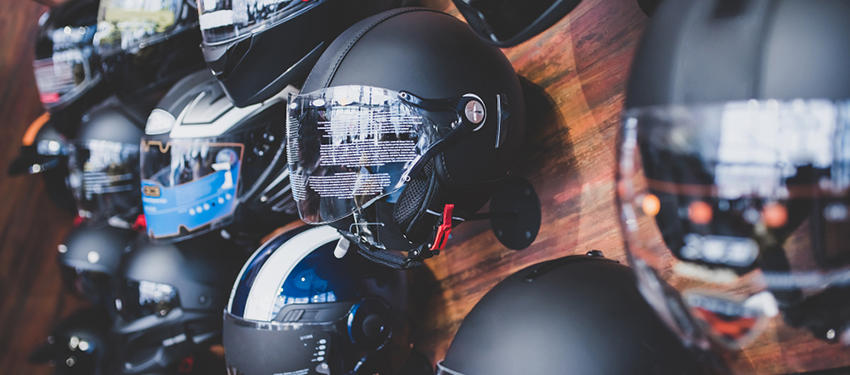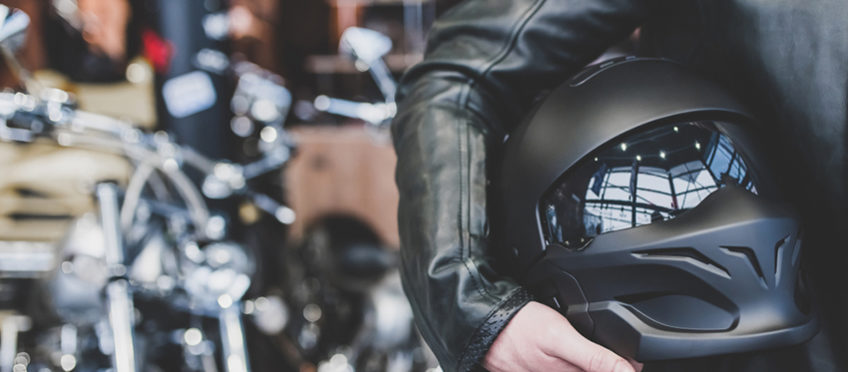A motorcycle helmet is arguably a motorcyclist’s most important piece of safety equipment. With so many choices in style, design, and price, it’s hard to know how to choose the one that’s best for you. The right helmet makes a huge difference in protection, comfort, and rider fatigue.
Here’s a primer to guide you on your purchase decision.
Styles
Helmets come in four basic styles:
1. Full face: covers the top, back, and front of your head, including your chin. Studies have shown that 35% of helmet impacts occur in the jaw and chin area.
2. Modular: essentially a full face helmet with a chin bar that flips up.
3. Open face or three-quarter shell: covers the top, back, and sides of your head but not your face. May or may not come with a visor.
4. Half shell or beanie: covers your head from your forehead to about half way down the back of your head.
Different styles are popular with different kinds of riding. Sport bike riders prefer aerodynamic full-face helmets. Sport touring and adventure riders like the convenience of flipping up the chin bar when stopped for conversation or hydration, or to cool off at a stop sign.
Cruiser and scooter riders like the airy feeling and look of open face helmets. Half helmets are also popular with cruiser and vintage bike riders. Half and three-quarter helmets offer the least protection from trauma and the elements—bugs, road debris, and noise. Over time, those factors contribute to fatigue, hindered concentration, and hearing loss. Full face helmets are more likely to have an aerodynamic design which further reduces fatigue.

Construction
Street helmets have four structural components:
1. The outer shell: a rigid layer designed to protect against abrasion and penetration. Most shells are constructed from polycarbonate or fibreglass. More recently, carbon fibre has become popular because of its light weight, tensile strength, and the way it distributes energy upon impact. It’s also pricier.
2. The interior foam lining: a thick layer of expanded polystyrene (EPS) foam, designed to absorb and disperse energy from a crash that would otherwise be absorbed by the skull and brain.
3. The chin strap: to ensure the helmet remains on the head.
4. The soft fabric liner: to aid comfort and fit.
Safety Standard
The Highway Traffic Act of Ontario requires helmets worn by motorcycle riders to meet DOT (American) or ECE (European) standards. Certifying agencies test the helmet’s ability to disperse the impact force and ensure the chin strap will remain in position and not allow the helmet to rotate or come off. Helmets that meet this certification come with a DOT or ECE sticker applied to the outside back. Some novelty helmet sellers provide DOT stickers to apply after purchase. These helmets do not meet safety standards.
How to Select the Right Helmet
1. Fit. A helmet should fit snugly all around your head and face, tight enough that if you try moving it on your head, your skin moves with it. Manufacturers produce different shell and liner shapes and each helmet style will fit your head differently. Try a helmet on and walk around the store with it for fifteen minutes. If you wear glasses while you ride, make sure they fit comfortably under your helmet. If there are pressure points or areas of discomfort, find another style. If it’s uncomfortable in the store, it will feel like your head’s in a vise while you’re riding. They don’t get broken in.
2. Vision. Select a helmet with a high-quality face shield, free of distortions. Look for an anti-fog coating or a Pinlock (internal lens) visor to reduce fogging. An internal sun visor is also a handy feature. Note the amount of peripheral vision when you’re wearing the helmet.
3. Ventilation. Good airflow helps keep you cool and dilutes toxic exhaust gases that can build up inside your helmet. Look for a chin vent, top vents, and holes in the EPS liner that line up with the vents.
4. Comfort. Sweat and hair products can cause the comfort liner to break down, affecting rider comfort and fit. Purchasing a helmet with a removable liner and washing it will prolong its useful life.
NEVER buy a used helmet. Even though it shows no signs of damage, you don’t know what you’re getting, and you’re relying on it to protect you. Helmets have a useful life of approximately five years before they need replacing. Saving a few dollars on a used or old helmet is not worth the potential cost to your safety.
Some riders use helmets to make a fashion statement. While we all want to look fantastic and well put together, make looks the last consideration in your purchase decision. Injuries to your brain and spinal cord can be serious and irreversible. A well-constructed and properly fitting helmet can greatly reduce the effects of trauma.
New DOT approved open face helmets are available for less than $100. Full face helmets start around $125. Ventilation, sound reduction, weight, aerodynamics, and the quality of comfort liner, factors which improve comfort and reduce fatigue especially on longer rides, improve as the price increases. Graphics add cost and serve a cosmetic function only.









join the conversation